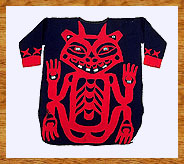
 Clothing Clothing
 Headresses Headresses
 Raven Rattles Raven Rattles
 Copper Shields Copper Shields |
Clothing (Tunics, Dance Aprons, and Leggings)
Another popular item of clothing in the late nineteenth century was a cloth tunic with a single crest on the front and sometimes another crest on the back. The most prestigious kind was the woven Chilkat tunic, which probably preceded the cloth one. The Chilkat tunic, like the blanket, was a specialty of the Tlingit, and the rare Haida examples were probably obtained in trade. Considerably more common among the Haida were Chilkat woven aprons and leggings, probably also imported from the Tlingit. The design fields on Chilkat tunics, aprons and leggings followed those of the blanket, with slight adaptations because of differences in size and shape.

 |
The bold design of a Mountain Goat crest on a clan tunic of red and dark blue wool trade cloth, adorned with pieces of abalone shell.
Probably acquired at Kasaan village in Alaska circa 1900 by George T. Emmons for the Lord Bossom collection.
CMC VII-X-1078 (S94-6740) |

Clothing worn by chiefs under the Chilkat blanket typically included a dance apron (or wraparound skirt), leggings of leather or cloth, and simple undecorated moccasins. Early aprons were made of tanned deerskin, painted in red and black with elaborate formline designs similar to those on boxes and even housefronts. There is usually a single large Konankada figure, often embellished with human heads in its mouth, but Whale and Raven designs are also common. A few examples, possibly traded from the mainland, are decorated with porcupine quill embroidery. The aprons are fringed at the bottom, a holdover from the ancient skin apron of the shaman. To the fringes are attached deer hooves or brass thimbles to produce a distinctive sound as the wearer moves.
Late in the last century, dance aprons of heavy wool cloth appeared among the Haida but never replaced leather aprons to the same degree as they did among mainland peoples. The decoration consists of a single family crest, cut from red cloth and appliquéd onto the dark blue apron.
Leggings are decorated in much the same way as dance aprons. Early leggings were made of leather, with complex figures painted on them and quill embroidery. After contact, cloth leggings with appliquéd crest figures became popular. The Haida often added puffin beaks or deer hooves as janglers.
|